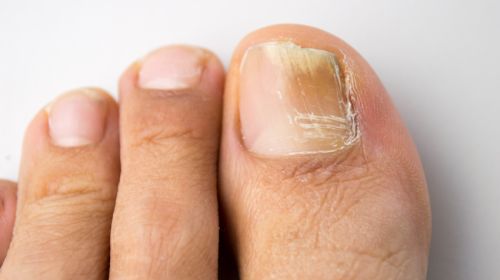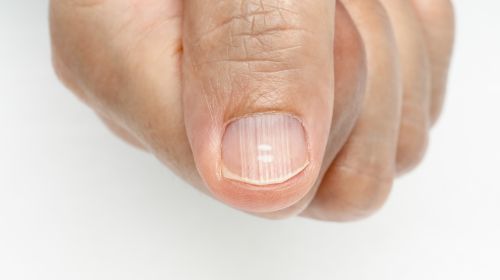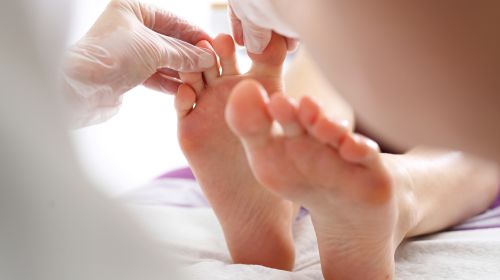Nail fungus is contagious. The pathogens can be found everywhere in our environment and feel particularly comfortable where it is warm and humid. These behavior tips and hygiene rules help to minimize the risk of infection.
- Well-groomed, healthy feet are the best protection against nail fungus.
- © iStock.com / peopleImages
Annoying infections with nail fungus can be caught everywhere and in different ways. Athletes, diabetics and the elderly are particularly at risk. But adhering to simple rules of conduct can significantly minimize the risk.
Overview of article content:
General tips on behavior against nail fungus
On healthy and well-groomed feet, fungal pathogens from nail and athlete's foot have little chance. With regular foot care, you ensure that the skin, toes and toenails remain intact and that there are no entry points for infections. After washing, showering and bathing, the feet are dried thoroughly – including the spaces between the toes. If the feet have been in the water for a longer period of time, they can also be dried with a hair dryer. Applying cream afterwards keeps the skin supple.
You can find detailed tips for the care of hands, feet and nails in this article.
When caring for and pedicuring the feet, changes in the nails and dry, flaky skin between the toes are quickly noticed. These signs are symptoms of nail fungus and athlete's foot. One should not wait for the doctor to diagnose these changes. Because nail fungus is contagious, family members can quickly become infected.
If you regularly let your feet breathe and don't force them into tight, closed shoes all day, you're doing something good for them. Shoes should be changed regularly and well ventilated – even if you do not belong to a risk group. Breathable materials for shoes and socks made of cotton or wool also ensure a pleasant foot climate.
Walking barefoot hardens
Regular barefoot walking is a good way to prevent nail fungus. It hardens the soles of the feet and promotes blood circulation in the feet. Especially when walking barefoot in the forest, on the beach or in the park, the many small bumps in the floor look like a natural massage.
Anyone who is already suffering from nail fungus or athlete's foot and is in treatment is subject to somewhat stricter hygiene rules. Affected people should feel responsible not to infect other people. This also includes early and consequent treatment until the nail fungus infection has completely healed. Especially in swimming pools and sports clubs and there are many sources of infection.
Treat nail fungus properly
Lifeline / Wochit
Prevention in swimming pool, sauna, outdoor pool
The warm, humid climate in public baths and leisure facilities is an ideal environment for all kinds of fungus pathogens. Walking barefoot and the accumulation of many people mean that there is a high risk of infection for nail and athlete's foot in public bathing facilities. Both healthy and particularly vulnerable people, such as athletes, and the elderly should follow some rules so that no unwanted souvenir is left after bathing or wellness fun. If you already have nail fungus, you can protect others – without having to do without swimming or swimming pools.
Barefoot walking in the swimming pool is taboo
The most important measure in the swimming pool remains: never walk barefoot. This applies to both healthy and infected people. Because the risk of infection lurks less outside than in the chlorinated water. The mushroom spores can last for months on bath mats, lying mats and floor coverings of all kinds.
Even in barefoot areas, bathing shoes should always be left on. If you don't want to show your bare feet due to an existing nail fungus infection, you can use models that leave the nail zone covered.
Disinfect laundry and shoes
Patients with nail fungus should not let their own towels in the swimming pool be used by others to protect those who are not infected. An extra towel for the affected areas prevents the fungus from being transferred to healthy nails. After visiting the swimming pool, towels should be washed at least 65 degrees, better at 90 degrees, in order to effectively kill the spores. Bathing shoes should also be disinfected regularly.
Caution, here there are dangers of nail fungus!
Lifeline / Wochit
After the bath: dry your feet
With moist, soaked nails, the nail fungus has an easy time penetrating healthy nails. After visiting the swimming pool, it is therefore important to ensure that your feet and hands are dry – especially the areas between your toes and fingers. Damp, softened skin areas are best dried with a hair dryer (put on cold). If you apply cream or oil to your hands and feet, including your nails, after visiting the swimming pool, it will also make it difficult for the fungus.
To the outdoor pool with nail fungus?
The same hygiene rules – wearing flip-flops, thoroughly drying your feet, caring for and applying nails and treating existing nail fungus – also apply in principle to a visit to the outdoor pool in summer.
If you already have a foot or nail fungus, you can also do without the outdoor pool altogether and refresh yourself in summer in a remote lake that is not populated by many bathers.
Avoid foot showers in the swimming pool
There are often foot showers in the swimming pool to disinfect your feet. Foot disinfection is no good against fungal spores. On the contrary: the area around the foot showers is particularly contaminated with fungi. When used, innumerable infected skin cells are inevitably washed away. These flow to the floor with the washing liquid and the fungal spores are easily transferred.
In addition, the disinfectant solutions need a contact time of at least five minutes. But most swimmers only keep their feet under the spray for a few seconds.
In addition, the disinfectants attack the acid and grease protective coating on the skin and the nail surface and "open" the nail for fungal attack. For this reason, many bathing establishments do away with their anti-athlete's foot showers.
How athletes can prevent
The accumulation of nail fungus in athletes has various reasons. First of all, there is the high risk of infection in sports facilities. However, the risk of infection for nail fungus during exercise can be significantly reduced.
The most important protection is thorough foot hygiene. Regular washing, careful drying or blow drying of the feet should be a matter of course, as well as disinfecting the laundry and towels. Bath slippers should be worn in washrooms, showers, changing rooms and swimming pools.
Prefer breathable shoes
Sports shoes should be selected with care. Breathable shoes give off sweat and keep your feet dry when hiking, jogging, soccer or inline skating. In addition, the shoes must never be bought too small: Shoes that are too tight increase the risk of injury to the foot and thus favor a nail fungus. Sports shoes should never be worn without socks – the stockings must also fit well. Linked seams and folds in the stockings can cause the skin to chaf.
Alternate shoes and ventilate well
Fungal pathogens can survive in shoes for a while: therefore, change sneakers and stockings as often as possible and in any case if the feet have sweated heavily after prolonged physical exertion. A pair of replacement shoes are always good. You should ventilate the wet shoes well and disinfect them if necessary. Freezing the shoes, as is sometimes recommended, is of no use. Fungus spores are often designed so that they can withstand the most adverse conditions. The cold alone cannot kill them completely.
Caution is advised with rental shoes. Ski shoes or bowling shoes are usually disinfected, but you can never know how exactly the rental staff will take these measures. It is better to use your own footwear when exercising.
Optimal nail care: how it works
Lifeline / Wochit
Protect family from infection: rules for at home
Although many people automatically associate the risk of infection with swimming pools or public showers, it is at least as high in their own home. If you already have nail fungus, you should exercise caution to protect your family from infection.
First of all, it is important to have changes in the skin and nails examined immediately by a doctor. Because many sufferers attribute itchy, flaky skin and nail discoloration to causes other than fungal diseases. This takes an average of six years before those affected consult an expert. During this time, the spores can spread further. However, anyone who knows about his illness can do a lot to protect his family from it.
-

Changes to the fingernails and toenails can indicate a nail fungus infection. With ten questions from our check, you can check whether you have nail fungus.
Test now!
My towel – your towel
Fungus spores survive not only in stockings and shoes, but also in carpets, towels or bath mats. Each family member therefore only uses their own towel. In addition, bath mats and bed rugs should be washed as often as possible at at least 60 degrees. Likewise, bed linen and other textiles with which the person concerned comes into direct contact. Slippers or flip-flops should be worn in the house to avoid spreading them over the carpet. And keep in mind: Vacuuming cannot remove all fungal spores. Only a disinfectant carpet can help here.
Checklist: The most important tips for preventing nail fungus
The care of hands, feet and nails and their regular inspection are among the basic measures.
Always dry hands and feet well. Particular attention should be paid to the spaces between the toes. Fungi love a humid climate and fungal infections often start between the toes.
Even if mobility is limited, you should older people do not do without foot care, because they belong to the risk group for nail fungus. In these cases, help from third parties is essential. If no relatives are considered for this, regular use of medical foot care is a good solution.
Shoes, socks and tights should be comfortable and breathable be. If your feet are cold, wool socks or thick socks made of 100 percent cotton are the suitable sources of heat. You should avoid synthetic materials and shoes that are too tight.
Shoes should be changed several times a day, and stockings at least daily.
Towels and socks belong in the hot wash. Towels should also be changed at least once a week or immediately after use if used in public places.
If they are not washable, shoes can be sprayed with antifungal sprays or powders disinfect.
Regular barefoot walking strengthens and blood circulation in the feet and prevents sweaty feet.
risk groups and people who already have nail fungus should avoid walking barefoot in public facilities such as swimming pools, saunas, shower rooms and changing rooms. Always wear bathing shoes.
Avoid foot showers at public disinfectant dispensers.
Anyone who already has athlete's foot or nail fungus should have one own pedicure instruments Use (nail scissors, nail file and other) and disinfect them after use.




